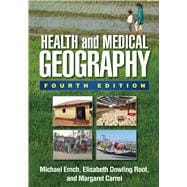Why are rainfall, carcinogens, and primary care physicians distributed unevenly over space? The fourth edition of the leading text in the field has been updated and reorganized to cover the latest developments in disease ecology and health promotion across the globe. The book accessibly introduces the core questions and perspectives of health and medical geography and presents cutting-edge techniques of mapping and spatial analysis. It explores the intersecting genetic, ecological, behavioral, cultural, and socioeconomic processes that underlie patterns of health and disease in particular places, including how new diseases and epidemics emerge. Geographic dimensions of health care access and service provision are addressed. More than 100 figures include 16 color plates; most are available as PowerPoint slides at the companion website.
New to This Edition:
*Chapters on the political ecology of health; emerging infectious diseases and landscape genetics; food, diet, and nutrition; and urban health.
*Coverage of Middle East respiratory syndrome, Ebola, and Zika; impacts on health of global climate change; contaminated water crises in economically developed countries, including in Flint, Michigan; China's rapid industrial growth; and other timely topics.
*Updated throughout with current data and concepts plus advances in GIS.
Pedagogical Features:
*End-of-chapter review questions and suggestions for further reading.
*Section Introductions that describe each chapter.
*"Quick Reviews"--within-chapter recaps of key concepts.
*Bold-faced key terms and an end-of-book glossary.
New to This Edition:
*Chapters on the political ecology of health; emerging infectious diseases and landscape genetics; food, diet, and nutrition; and urban health.
*Coverage of Middle East respiratory syndrome, Ebola, and Zika; impacts on health of global climate change; contaminated water crises in economically developed countries, including in Flint, Michigan; China's rapid industrial growth; and other timely topics.
*Updated throughout with current data and concepts plus advances in GIS.
Pedagogical Features:
*End-of-chapter review questions and suggestions for further reading.
*Section Introductions that describe each chapter.
*"Quick Reviews"--within-chapter recaps of key concepts.
*Bold-faced key terms and an end-of-book glossary.








